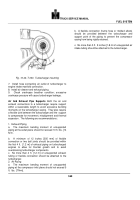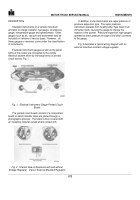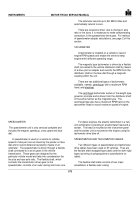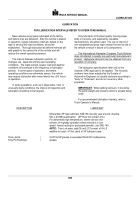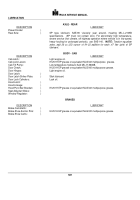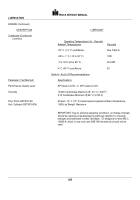TM-5-3805-254-14-P-2 - Page 583 of 894
TRUCK SERVICE MANUAL
INSTRUMENTS
Fig. 24.
Checking Fuel Level Gauge System Components
As the tank unit resistance varies between the
extremes of 0 and 90 ohms due to changes in the fuel
level, current flow divides proportionately between the
two possible paths from point B to ground.
The resultant
magnetic fields around the coils control the position of
the magnet and pointer through the range of scale
readings from empty to full.
The sender and ignition terminals are connected by
a calibrating resistor, Fig. 23.
The odd terminal is the
ground terminal.
The sender terminal is the first terminal clockwise
from the ground terminal when viewed from the back
side of gauge.
NOTE:
The ground terminal provides a
ground between the gauge and its housing or cover.
The
housing is grounded to the chassis through the mounting
studs.
When the key switch is turned off, the pointer will
not necessarily return to the empty position.
This is
inherent in the instrument and does not indicate a faulty
part.
To determine faulty component, proceed as follows:
1.
Disconnect wire at tank sender unit, Fig. 24.
2.
Connect SE-2081 Fastestor lead "A" to end of
sender unit wire and Fastestor lead "B" to ground.
3.
Turn ignition switch to "on."
4.
Set Fastestor left-hand control knob to "90" and
right-hand control knob to "0.
" Fuel
gauge should read slightly above "full.
" If tests are
satisfactory, indication is that receiver unit and wiring
from tank unit to receiver is functioning properly and
that tank unit is faulty or is insufficiently grounded to
tank.
5.
Disconnect Fastestor and reconnect wire at tank
unit.
6.
If receiver unit does not respond properly to above
tests, disconnect tank sender unit to receiver wire
from receiver unit terminal, Fig. 25.
7.
Connect Fastestor lead "A" to receiver unit at sender
terminal and lead "B" to ground.
8.
Turn ignition switch to "on."
9.
Set Fastestor left-hand control knob to "90" and
right-hand control knob to "0.
" Gauge should read
slightly below "empty.
" Turn ignition switch "off."
NOTE:
A standard test light may be used to check
wire continuity. Replace any units or wiring found
defective.
Oil Temperature Gauge:
The electrical oil temperature gauge consists of two
basic components--the dash gauge and a thermister
sending unit.
The gauge indicates the oil temperature,
while the sender controls the gauge reading.
The two
units are connected electrically as shown in Fig. 8.
576B
Back to Top


